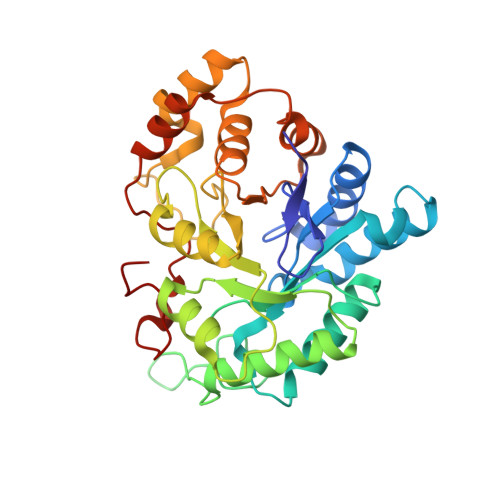High-Resolution Structures of Human Aldose Reductase Holoenzyme in Complex with Stereoisomers of the Potent Inhibitor Fidarestat: Stereospecific Interaction between the Enzyme and a Cyclic Imide Type Inhibitor
El-Kabbani, O., Darmanin, C., Oka, M., Schulze-Briese, C., Tomizaki, T., Hazemann, I., Mitschler, A., Podjarny, A.(2004) J Med Chem 47: 4530-4537
- PubMed: 15317464
- DOI: https://doi.org/10.1021/jm0497794
- Primary Citation of Related Structures:
1X96, 1X97, 1X98 - PubMed Abstract:
Structure determinations of human aldose reductase holoenzyme in complex with the 2S4R-,2R4S- and 2R4R-isomers of the potent inhibitor Fidarestat ((2S,4S)-6-fluoro-2',5'-dioxospiro[chroman-4,4'-imidazoline]-2-carboxamide) were carried out in order to elucidate the binding modes responsible for the differences in their inhibitory potencies. In the complex structure with the 2R4S-isomer the cyclic imide moiety formed hydrogen bonds with the side-chains of Trp111, Tyr48 and His110. In the attempt to determine the complex structure with the least potent 2R4R-isomer this ligand was not observed, and instead, the active site was simultaneously occupied by two citrate molecules (occupancies of 60% and 40%). In the case of 2S4R, the active site was occupied by a citrate molecule which anchors the 2S4R-isomer from its carbamoyl group. The structures of the complexes suggest that the differences in the interactions between the cyclic imide rings and carbamoyl groups of the compounds with residues His110, Trp111, Trp219 and Cys298 account for differences in their inhibitory potencies.
- Department of Medicinal Chemistry, Victorian College of Pharmacy, Monash University (Parkville Campus), 381 Royal Parade, Parkville, Vic 3052, Australia. Ossama.El-Kabbani@vcp.monash.edu.au
Organizational Affiliation:


















